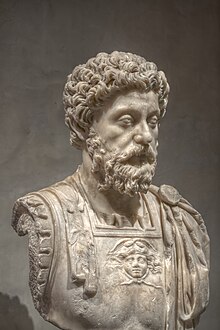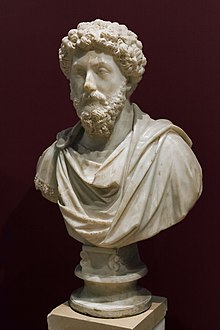ATTENTION: Dear Customers, you will receive exactly the same item which you see on the pictures, not similar or other. Please read the description carefully and review the photos. Delivery items combine.
Marcus Aurelius
Marcus Aurelius 
Roman emperor Reign 8 March 161 – 17 March 180
(19 years) Predecessor Antoninus Pius Successor Commodus Co-emperor - Lucius Verus (161–169)
- Commodus (177–180)
Born 26 April 121
Rome, Italy Died 17 March 180 (aged 58)
Sirmium, Pannonia Burial Spouse Faustina the Younger (145-175, her death) Issue
Detail 14, including Commodus, Annius, Lucilla, Annia Galeria Aurelia Faustina, Fadilla, Annia Cornificia Faustina Minor, and Vibia Aurelia Sabina Names Marcus Aelius Aurelius Verus Caesar
(see section Name for details) Regnal name Imperator Caesar Marcus Aurelius Antoninus Augustus
Dynasty Nerva–Antonine Father - Marcus Annius Verus
- Antoninus Pius (adoptive)
Mother Domitia Calvilla
Philosophy careerNotable work Meditations
Era Hellenistic philosophy Region Western Philosophy School Stoicism Main interests Ethics Notable ideas Memento mori[1]
| Marcus Aurelius | |||||||||
|---|---|---|---|---|---|---|---|---|---|
 | |||||||||
| Roman emperor | |||||||||
| Reign | 8 March 161 – 17 March 180 (19 years) | ||||||||
| Predecessor | Antoninus Pius | ||||||||
| Successor | Commodus | ||||||||
| Co-emperor |
| ||||||||
| Born | 26 April 121 Rome, Italy | ||||||||
| Died | 17 March 180 (aged 58) Sirmium, Pannonia | ||||||||
| Burial | |||||||||
| Spouse | Faustina the Younger (145-175, her death) | ||||||||
| Issue Detail | 14, including Commodus, Annius, Lucilla, Annia Galeria Aurelia Faustina, Fadilla, Annia Cornificia Faustina Minor, and Vibia Aurelia Sabina | ||||||||
| |||||||||
| Dynasty | Nerva–Antonine | ||||||||
| Father |
| ||||||||
| Mother | Domitia Calvilla | ||||||||
Philosophy career | |||||||||
Notable work | Meditations | ||||||||
| Era | Hellenistic philosophy | ||||||||
| Region | Western Philosophy | ||||||||
| School | Stoicism | ||||||||
Main interests | Ethics | ||||||||
Notable ideas | Memento mori[1] | ||||||||
Influences | |
Influenced | |
| Roman imperial dynasties | ||||||||||||||
|---|---|---|---|---|---|---|---|---|---|---|---|---|---|---|
 | ||||||||||||||
| Nerva–Antonine dynasty (AD 96–192) | ||||||||||||||
| Chronology | ||||||||||||||
| ||||||||||||||
| Family | ||||||||||||||
| Succession | ||||||||||||||
| ||||||||||||||
 |
| Part of a series on |
| Marcus Aurelius |
|---|
Early life (121–161 AD) |
| Part of a series on |
| Stoicism |
|---|
   |
 Philosophy portal
Philosophy portal
Marcus Aurelius Antoninus (/ɔːˈriːliəs/ ə-REE-lee-əs; Latin: [ˈmaːrkʊs̠ au̯ˈreːlijʊs̠ an̪t̪oːˈniːnʊs̠]; 26 April 121 – 17 March 180) was Roman emperor from 161 to 180 and a Stoic philosopher. He was the last of the rulers known as the Five Good Emperors (a term coined some 13 centuries later by Niccolò Machiavelli), and the last emperor of the Pax Romana (27 BC to 180 AD), an age of relative peace and stability for the Roman Empire. He served as Roman consul in 140, 145, and 161.
Marcus was born during the reign of Hadrian to the emperor's nephew, the praetor Marcus Annius Verus, and the heiress Domitia Calvilla. His father died when he was three, and his mother and grandfather raised Marcus. After Hadrian's adoptive son, Aelius Caesar, died in 138, the emperor adopted Marcus' uncle Antoninus Pius as his new heir. In turn, Antoninus adopted Marcus and Lucius,
the son of Aelius. Hadrian died that year and Antoninus became emperor.
Now heir to the throne, Marcus studied Greek and Latin under tutors
such as Herodes Atticus and Marcus Cornelius Fronto. He kept in close correspondence with Fronto for many years afterward. Marcus married Antoninus' daughter Faustina in
145. After Antoninus died in 161, Marcus acceded to the throne
alongside his adoptive brother, who took the name Lucius Verus.
The reign of Marcus Aurelius was marked by military conflict. In the East, the Roman Empire fought successfully with a revitalized Parthian Empire and the rebel Kingdom of Armenia. Marcus defeated the Marcomanni, Quadi, and Sarmatian Iazyges in the Marcomannic Wars; however, these and other Germanic peoples began to represent a troubling reality for the Empire. He modified the silver purity of the Roman currency, the denarius. The persecution of Christians in the Roman Empire appears to have increased during Marcus' reign, but his involvement in this is unknown. The Antonine Plague broke out in 165 or 166 and devastated the population of the Roman Empire, causing the deaths of five million people. Lucius Verus may have died from the plague in 169.
Unlike some of his predecessors, Marcus chose not to adopt an heir. His children included Lucilla, who married Lucius, and Commodus, whose succession after Marcus has been a subject of debate among both contemporary and modern historians. The Column and Equestrian Statue of Marcus Aurelius still stand in Rome, where they were erected in celebration of his military victories. Meditations,
the writings of "the philosopher" – as contemporary biographers called
Marcus, are a significant source of the modern understanding of ancient
Stoic philosophy. They have been praised by fellow writers,
philosophers, monarchs, and politicians centuries after his death.
Marcus Aurelius Antoninus (/ɔːˈriːliəs/ ə-REE-lee-əs; Latin: [ˈmaːrkʊs̠ au̯ˈreːlijʊs̠ an̪t̪oːˈniːnʊs̠]; 26 April 121 – 17 March 180) was Roman emperor from 161 to 180 and a Stoic philosopher. He was the last of the rulers known as the Five Good Emperors (a term coined some 13 centuries later by Niccolò Machiavelli), and the last emperor of the Pax Romana (27 BC to 180 AD), an age of relative peace and stability for the Roman Empire. He served as Roman consul in 140, 145, and 161.
Marcus was born during the reign of Hadrian to the emperor's nephew, the praetor Marcus Annius Verus, and the heiress Domitia Calvilla. His father died when he was three, and his mother and grandfather raised Marcus. After Hadrian's adoptive son, Aelius Caesar, died in 138, the emperor adopted Marcus' uncle Antoninus Pius as his new heir. In turn, Antoninus adopted Marcus and Lucius, the son of Aelius. Hadrian died that year and Antoninus became emperor. Now heir to the throne, Marcus studied Greek and Latin under tutors such as Herodes Atticus and Marcus Cornelius Fronto. He kept in close correspondence with Fronto for many years afterward. Marcus married Antoninus' daughter Faustina in 145. After Antoninus died in 161, Marcus acceded to the throne alongside his adoptive brother, who took the name Lucius Verus.
The reign of Marcus Aurelius was marked by military conflict. In the East, the Roman Empire fought successfully with a revitalized Parthian Empire and the rebel Kingdom of Armenia. Marcus defeated the Marcomanni, Quadi, and Sarmatian Iazyges in the Marcomannic Wars; however, these and other Germanic peoples began to represent a troubling reality for the Empire. He modified the silver purity of the Roman currency, the denarius. The persecution of Christians in the Roman Empire appears to have increased during Marcus' reign, but his involvement in this is unknown. The Antonine Plague broke out in 165 or 166 and devastated the population of the Roman Empire, causing the deaths of five million people. Lucius Verus may have died from the plague in 169.
Unlike some of his predecessors, Marcus chose not to adopt an heir. His children included Lucilla, who married Lucius, and Commodus, whose succession after Marcus has been a subject of debate among both contemporary and modern historians. The Column and Equestrian Statue of Marcus Aurelius still stand in Rome, where they were erected in celebration of his military victories. Meditations, the writings of "the philosopher" – as contemporary biographers called Marcus, are a significant source of the modern understanding of ancient Stoic philosophy. They have been praised by fellow writers, philosophers, monarchs, and politicians centuries after his death.
Sources
The
major sources depicting the life and rule of Marcus are patchy and
frequently unreliable. The most important group of sources, the
biographi contained in the Historia Augusta,
claimed to be written by a group of authors at the turn of the 4th
century AD, but it is believed they were in fact written by a single
author (referred to here as 'the biographer') from about 395 AD. The
later biographies and the biographies of subordinate emperors and
usurpers are unreliable, but the earlier biographies, derived primarily
from now-lost earlier sources (Marius Maximus or Ignotus), are much more accurate. For Marcus's life and rule, the biographies of Hadrian, Antoninus, Marcus, and Lucius are largely reliable, but those of Aelius Verus and Avidius Cassius are not.
A body of correspondence between Marcus's tutor Fronto and
various Antonine officials survives in a series of patchy manuscripts,
covering the period from c. 138 to 166. Marcus's own Meditations offer
a window on his inner life, but are largely undateable and make few
specific references to worldly affairs. The main narrative source for
the period is Cassius Dio, a Greek senator from Bithynian Nicaea who
wrote a history of Rome from its founding to 229 in eighty books. Dio
is vital for the military history of the period, but his senatorial
prejudices and strong opposition to imperial expansion obscure his
perspective. Some other literary sources provide specific details: the
writings of the physician Galen on the habits of the Antonine elite, the orations of Aelius Aristides on the temper of the times, and the constitutions preserved in the Digest and Codex Justinianeus on Marcus's legal work. Inscriptions and coin finds supplement the literary sources.
The major sources depicting the life and rule of Marcus are patchy and frequently unreliable. The most important group of sources, the biographi contained in the Historia Augusta, claimed to be written by a group of authors at the turn of the 4th century AD, but it is believed they were in fact written by a single author (referred to here as 'the biographer') from about 395 AD. The later biographies and the biographies of subordinate emperors and usurpers are unreliable, but the earlier biographies, derived primarily from now-lost earlier sources (Marius Maximus or Ignotus), are much more accurate. For Marcus's life and rule, the biographies of Hadrian, Antoninus, Marcus, and Lucius are largely reliable, but those of Aelius Verus and Avidius Cassius are not.
A body of correspondence between Marcus's tutor Fronto and various Antonine officials survives in a series of patchy manuscripts, covering the period from c. 138 to 166. Marcus's own Meditations offer a window on his inner life, but are largely undateable and make few specific references to worldly affairs. The main narrative source for the period is Cassius Dio, a Greek senator from Bithynian Nicaea who wrote a history of Rome from its founding to 229 in eighty books. Dio is vital for the military history of the period, but his senatorial prejudices and strong opposition to imperial expansion obscure his perspective. Some other literary sources provide specific details: the writings of the physician Galen on the habits of the Antonine elite, the orations of Aelius Aristides on the temper of the times, and the constitutions preserved in the Digest and Codex Justinianeus on Marcus's legal work. Inscriptions and coin finds supplement the literary sources.

